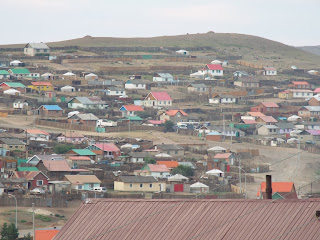Dogs are everywhere. I think that I have seen maybe 50
different dogs of various age and size. I have seen some really cute puppies,
and some raggedy old mutts. For all of the dogs I have seen, I have yet to
touch one. The first prominent reason is because I haven’t finished my Rabies
series that Peace Corps is administering. We all only have one more shot to
complete the vaccine. The second reason is because you don’t touch Mongolian
dogs. Period. Not unless you want to risk a bite.
The Mongolians do not treat dogs the same way as we do in
America. They see the dogs more as tools than as pets. A Haasha (word refers to fence surrounding a family
compound/yard) dog is often used to guard fenced in compounds, and is only
friendly with people in its family. I have often thought that I get along well
with dogs, but I have since realized that I get along with American dogs. The
dogs here are more closely related to wolves and should be treated with the
same respect. Because I am new, I have been barked at more times than I can
count. Most of the time, the dogs bark at me from the safety of their fences
warning me to stay away. Dogs on the street seem to be more focused on giving
everyone a wide berth.
Family Cows outside the Gers
Many Mongolians fear dogs, because they have had personal
experience as a child with an angry one. They will often throw objects or beat
away the dogs with sticks. This may seem dangerous or abusive, but it is only a
cultural difference in treatment of the animals. I should also note that not
all Mongolians treat dogs the same way. I have seen a number of dogs following
masters in loving obedience.
It is extremely rude to throw keys to another person in
Mongolia. Keys are only thrown at dogs.
Kids playing soccer down the street
Politeness and directness are key virtues of Mongolian
culture. If you bump into someone or step on their toes, it is important to
press their hand afterword while saying, “I’m Sorry/Excuse me,” in Mongolian.
One of my fellow volunteers stands at over six and a half
feet tall. While walking behind him through the market I noticed a number of
people running up to him exclaiming how tall he was. He may be the tallest
person they have ever seen.
In another instance after a meal, I got out my
Mongolian/English phrase book and pointed to “Be careful when you lift me,” as
a jest at some of the strange phrases in the book. (I later realized that I was insinuating that I was stuffed with food,
because I pointed right after dinner.) My family thought it was funny;
however they interpreted it, and chuckling merrily, my host mother, wrote down
my weight. She then insinuated in so few words that they would not be lifting
me. (In an earlier blog I mention being
weighed by my host mother who is the school doctor.)
Sunset from highest point on Family Haasha
The Mongolians are far more collectivist in culture than
America; which is mostly individualistic. They do spend a lot of time with
family, and often extended family life under one roof. In Mongolia it is family
first and then job/career.
The Peace Corps has explained that Privacy is a foreign
concept to the Mongolians, who are comfortable living in tight spaces with
family. It has been expressed to us that Mongolians do not knock on a door
unless it is locked. If it isn’t they come right in. All of the host families
are told that their Americans may want to be by themselves for periods of time,
so my host family has given me plenty of space.
Prior to leaving for Mongolia, I shaved my beard. Since the
age of 15, I have sported some form of facial hair. Peace Corps required me to
shave, and at staging we were told that Mongolians do not like facial hair. I
operated under the assumption that this was a hygiene issue and they thought it
was dirty. Disliking facial hair strictly because of hygiene was a stance I
could not fully respect, and I hoped to grow a beard once we had established
credibility with our sight. Upon arriving to Ulaanbaatar the discussion of
facial hair took a different turn when it was explained by true Mongolians.
Facial hair is a distinction that elder men are allowed to have in respect to
their age. (Virtually all images of
Chinggas Haan display him with facial hair.) For a young person to have
facial hair is to disrespect your elders. This explanation makes sense to me,
and, while it still stings, I am coming to terms with the fact that I may have
to shave for two years.
Periodically Sally or I will post regarding cultural
differences that we notice. On a more temporal note, Sally and I are excited
about this weekend because I will be traveling to her host community to see her
and spend the night. It is the first of three visits that Peace Corps finances
for us while we are separated. In addition to these visits we will also get to
see each other for about 4 days at the end of the month during mid-days
training.
~Caleb






No comments:
Post a Comment